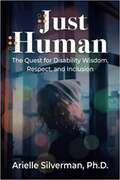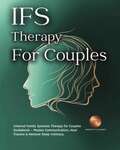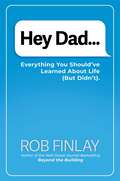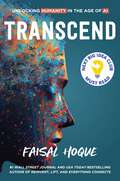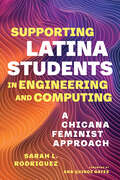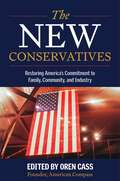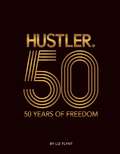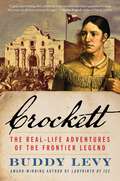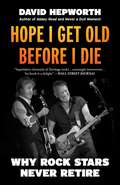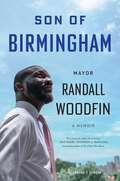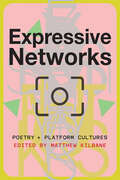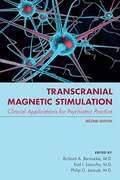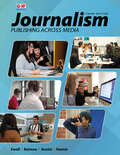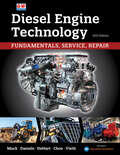- Table View
- List View
Just Human: The Quest For Disability Wisdom, Respect, And Inclusion
by Arielle SilvermanBorn without sight, Dr. Arielle Silverman has never missed the visual. Being blind never bothered her much but, as she grew, she discovered others saw her blindness very differently. Many people saw her as either helpless or inspirational, but rarely did they see her as just human, with the same capacities and desires as her peers. Arielle has spent a lifetime exploring ways to foster respect and inclusion, not only for blind people like her, but for all of us whose bodies or minds differ from the norm. <P><P> In Just Human, she reflects on her formative years and presents unique anecdotes from her life that carry teachable moments for all of us. She recalls the feel of her mother’s embrace, the smell of her grandparents’ brisket, the inner sensations of a preteen crush, the music on her wedding day, and scholarly lessons from her dissertation research. Her words paint pictures from her mind’s eye: a vision of a world where we can radically accept ourselves and our fellow humans, while at the same time work to change systems of inequality. As she writes of the past and the present, Arielle looks toward the future, considering how we can build a more inclusive world for those who come after us.
Folklore 101: An Accessible Introduction to Folklore Studies
by Jeana JorgensenWhen's the last time you got to pick a folklorist's brain? Did you know memes count as folklore? Or that folklorists assign numbers to fairy tales to keep track of them all? <p><p> The field of folklore studies is over two centuries old, and it's full of amazing insights about human behavior, creativity, and community. Folklore studies is as interdisciplinary as it gets, squished somewhere between anthropology and linguistics and religious studies and comparative literature and more. It’s all about the informal human interactions, the million tiny acts and stories and beliefs and arts that function as social glue even if they seem beneath notice. Do traditional holiday foods have a deeper meaning? Yep. Same with folk music, ballads, proverbs, jokes, urban legends, body art, and a ton more genres covered in this book. <p><p> Is the whole book as easy to read and irreverent as this description? Yep. This fun, accessible guide to the academic study of folklore packs in a college class's worth of material, from basic concepts and major folklore genres to special topics based on identity, fancy theories, and more. <p><p> If you've always wanted to take a folklore class, or you're a writer or artist using folklore in your work, or you're just generally interested in the topic, this is the book for you!
Knee Ability Zero
by Ben PatrickKnee Ability Zero is not a medical book, rather: it is a step-by-step manual which allows you to find and improve your pain-free ability, and this has resulted in over 2000 knee success stories for people of all ages and walks of life.Over 8 steps we build "from the ground up" - from your ankles to lower legs to knees to thighs to hips, improving the strength, control, and freedom you have over your body, with explanation of why each step helps your knees. The 8 steps take 15-20 minutes in total, and I suggest doing them up to 3 times per week.You do not need any weights, equipment, or special abilities for this program, and you can start applying Step 1 from the moment you open up the book!
Salah: A Believer's Ascension to the Heavens
by Fethullah GulenPrayer is an essential part of a Muslim&’s life. While a believer can pray and offer their devotions any time and any where they like, Islamic tradition prescribes a specific form of prayers to be performed at five different times of the day. It is a celebratory act of submission in which believers align themselves with all other creation by offering their praise and gratitude to God, the Merciful, the Compassionate, as they stand, bow, and prostrate in propriety. These daily prayers are called salah, and this book is an all-comprehensive exploration of this spiritual act by one of the leading Muslim scholars of our time. The focus in this book is more on the spiritual aspect of salah, rather than its formulaic details which can be easily found in countless other manuals.
Backpack Explorer: What Will You Find? (Backpack Explorer)
by Editors of Storey PublishingThis take-along field guide teaches kids to look and listen for nature everywhere, whether in a nature preserve, an urban park, or a suburban backyard. From worms, birds, and spiders to trees, flowers, and clouds, young explorers learn about nature all around them. Find out what different animals eat, how plants grow, and how identify fungi and lichen. It's the perfect guide for kids ages 4 to 8 who love exploring the outdoors. Gold Mom's Choice Award Winner This publication conforms to the EPUB Accessibility specification at WCAG 2.0 Level AA.
IFS Therapy for Couples: Internal Family Systems Therapy for Couples Guidebook - Master Communication, Heal Trauma & Restore Deep Intimacy
by Jessica FilipowskiIFS THERAPY FOR COUPLES: TRANSFORM YOUR RELATIONSHIP WITH INTERNAL FAMILY SYSTEMS Discover how to break free from recurring relationship patterns and create lasting intimacy through Internal Family Systems therapy. This practical guidebook shows you how to understand the parts of you and your partner that shape your relationship dynamics. Learn to recognize protective patterns, heal attachment wounds, and build genuine connection using IFS tools that work. Inside, you'll find real examples from couples who have transformed their relationships, practical exercises you can start using today, and clear protocols for handling triggers, improving communication, and deepening trust. Whether you're struggling with communication, recovering from relationship trauma, or simply wanting to create a stronger bond, this book provides a clear path forward. Written in accessible language and grounded in real relationship scenarios, this guide helps you: - Transform communication patterns that keep you stuck - Build emotional safety and trust - Heal relationship wounds together - Create lasting intimacy and connection - Understand and work with your protective parts - Access natural Self leadership in your partnership Perfect for couples looking to create positive change, therapists seeking practical IFS relationship tools, and anyone interested in applying Internal Family Systems to strengthen their relationship.
Grow Healthier as You Grow Older by the Father of Aerobics: How a Life Devoted to Preventive Medicine Fostered the Global Fitness Revolution
by Kenneth H. Cooper MD, MPHGrow Healthier as You Grow Older is a personal look at the history of the fitness revolution, a guide for preventive health and fitness to improve the quality and quantity of your life, and an inspirational account of Dr. Kenneth Cooper&’s lifelong dedication to the mission of serving others.These days, workouts come in a wide variety, from hot yoga to HIIT (high intensity interval training) classes, pickleball to hip-hop dance. Exercise can be used in three ways: for rest and relaxation, for muscle-building and figure-contouring, and for cardiorespiratory fitness. All three have merit but only one can protect you from disease and prolong your life, and that is exercise for cardiorespiratory fitness—or, as most people call it: cardio. Walking, running, cycling, swimming, dancing, tennis, dancing—anything that gets your heart rate up and causes you to increase your oxygen intake over a certain period of time. Our survival depends on our ability to take in oxygen and deliver it efficiently to every area of the body. Dr. Kenneth Cooper&’s work as a pioneering researcher and preventive medicine physician has proven the benefits of aerobic exercise and how physiological changes in the body positively impact your overall health—plus make you feel good. Learning to follow his 8 Steps to Get Cooperized™ may be the way to make you healthy again, as it could the entire world, and help extend your life by as much as 10 years. Even minimal improvements—such as going from being totally inactive to exercising just 30 minutes a day, most days per week—are enough to drastically alter the course of a person&’s life. Reduce your risk of Alzheimer&’s and dementia, chronic kidney disease, congestive heart failure, and certain types of cancer by moving more. Today, at age 94, after practicing and teaching the value of preventive medicine, Dr. Cooper continues to think about new ways of doing things, new ways of presenting and studying data, new ways of looking at prevention. Take a deep dive inside the mind of an icon. He&’s done the research for you. Now it&’s your choice to become healthier sooner than later.
Pardon of Innocence: An Inspiring Story of Faith and Freedom
by Lt Gen (Ret) Michael T. FlynnThe extraordinary and inspiring true story of Michael T. Flynn, the retired three-star general, former director of the Defense Intelligence Agency, and first National Security Advisor in the Donald Trump administration, who walked through fire and came out the other end stronger, wiser, and more determined than ever to vanquish America&’s foes—at home and abroad—and win the battle to restore our rights and freedoms.In Pardon of Innocence, Michael Flynn recounts his journey from a coastal New England upbringing to the deserts of Iraq and the mountains of Afghanistan, from the echelons of US power to the depths of a corrupt justice system that sought to silence him for prioritizing America&’s interests. Through his eyes, we see how the qualities that made him an exceptional soldier and leader also made him a target for adversaries like Barack Obama and Joe Biden, who saw his honesty and courage as direct threats to their flawed policies.Flynn&’s battle against a weaponized justice system—one that threatened his family and forced him out of the White House—stands as a testament to faith, family, and freedom. This gripping memoir unveils the conspiracy to silence Flynn, including the FBI&’s framing tactics and the truth behind his foreign policy efforts to benefit Americans.Pardon of Innocence tells the unprecedented and remarkable true story of Michael Flynn. It is a powerful narrative of struggle, redemption, and hope, inspiring patriots to safeguard the nation&’s core values for generations to come.
Becoming HER: Straight Talk for Healing, Embodying, and Radiating as Your Most Powerful Self
by Monica YatesA NEW YORK TIMES AND USA TODAY BESTSELLER Becoming HER: Straight Talk for Healing, Embodying, and Radiating as Your Most Powerful Self&“This book is for those women who don&’t want to be thrown into the box of being a perfect wife, mother, and housekeeper, and they don&’t want to be thrown into competition with other women for success, money, or getting to the &‘top.&’ What I&’ve seen in my work is that a lot of modern women want to be somewhere in the middle. They want to be able to have a career and purpose and be a mum, wife, and great lover. They want to have the safety of knowing they can pursue an incredible career opportunity, and be cherished, adored, and devoured by their man.&” ~Monica Yates Picture HER: a woman who moves through life with ease, grace, and confidence. She isn&’t caught up in the chaos of modern life. Instead, she exudes strength, radiates authenticity, and cultivates relationships that uplift her. Becoming HER is about healing your past, embodying your truest self, and radiating as the feminine woman you were born to be. In this groundbreaking book, Monica Yates, a celebrated coach and top 0.5% podcast host, shares her powerful H-E-R FrameworkTM: Heal the trauma and societal conditioning that hold you back. Embody the woman you&’re born to be, who balances her career, relationships, and personal well-being with ease. Radiate confidence and authenticity, creating a life of fulfillment and joy. Packed with science-backed insights, raw personal stories, and actionable tools, Becoming HER explores: Why modern expectations are burning women out—and how to break free. The power of embracing your feminine energy and healing your relationship with men. How polarity in relationships creates deep intimacy and satisfaction. The secrets to aligning your inner and outer worlds for lasting success and happiness. If you&’re ready to heal, grow, and glow, Becoming HER is your ultimate guide.
Hey Dad...: Everything You Should've Learned About Life (But Didn't).
by Rob J. FinlayHey Dad… is the ultimate guide for young adults stumbling into adulthood, packed with the life lessons you thought they would magically know by now—like how to land a job, manage money, and avoid putting diesel in their gas engine (yep, that happened).Stepping into adulthood feels like taking a leap off a cliff—one that you are not quite prepared for. From figuring out how to land your first job to managing your finances, renting your first apartment, and not panicking when your car breaks down, &“adulting&” can feel overwhelming. That&’s where Hey Dad… comes in.Written by Rob Finlay, a dad of four who&’s been on the receiving end of countless late-night &“Hey Dad, how do I…?&” phone calls, this book offers the life lessons you never knew you needed until you found yourself Googling &“how to fix a circuit breaker&” at 2 a.m.With advice from experts on everything from job hunting and personal finance to starting your own business, plus real stories about successes and failures that make adulthood feel like a never-ending learning curve, Hey Dad… is your go-to guide for surviving—and thriving—through life&’s most confusing transitions.Whether you&’re just graduated, moving into your first place, or just trying to figure out how to keep it all together, this book will help you approach adulthood with confidence, humor, and maybe a little less Googling.
What's Right with America: ...And How We Can Keep It That Way!
by Hon. Paul Johnson Larry AldrichRegardless of what you see on the nightly news or hear from politicians, America is the greatest superpower in history, and those who live here will experience a future of fantastic abundance for the remainder of the century and beyond.Is America&’s future as bright as its past? What&’s Right with America argues that not only is the answer &“Yes,&” but the nation&’s most incredible days are yet to come. Despite the challenges and divisions we face, America&’s true strength lies in its core principles and the resilient spirit of its people. From the vision of our Founding Fathers to the resilience and determination that have shaped our history, What&’s Right with America explores what makes the country uniquely capable of thriving in times of change. With inspiring stories and thought-provoking analysis, authors Paul Johnson and Larry Aldrich reveal how America&’s prosperity is rooted in more than just economic might—it&’s grounded in values like freedom, individual empowerment, and deep commitment to justice and liberty. Johnson and Aldrich have identified five defining characteristics that have propelled the United States to greatness, showing how these ideals can guide us through current and future challenges. Whether you&’re concerned about politics, society, or the economy, What&’s Right With America offers a powerful reminder that America&’s strength is more than just its leadership—it&’s in every citizen who believes in the promise of a better future. What&’s Right with America is a must-read for anyone who believes in America&’s potential and is looking for a roadmap to a brighter tomorrow. Join the movement to embrace optimism, uphold our founding ideals, and strengthen the spirit that makes America exceptional.
Transcend: Unlocking Humanity in the Age of AI
by Faisal HoqueThe question this book answers is, how can we use AI to unlock humanity&’s full potential while protecting what is most precious about the human experience?As humanity takes its first steps into the Age of Artificial Intelligence, we are only just beginning to think through the possibilities and the dangers this technology brings. But we do not have time for leisurely speculation. AI will overturn the world we know in our lifetimes, and we must prepare ourselves to meet the unprecedented changes that will soon be upon us. In Transcend: Unlocking Humanity in the Age of AI, Faisal Hoque, one of the world&’s leading management thinkers and technologists, and a bestselling author, provides readers with the road maps they need to tackle the most important questions of our generation. · A unique perspective that emerges at the intersection of philosophy, humanity, business, and technology · Powerful practical frameworks to guide the reader in thinking about and using AI · The OPEN framework for unlocking the potential of AI · The CARE framework for protecting against its dangers · Structured approaches to AI tailored for individuals, businesses, and government agencies
Supporting Latina Students in Engineering and Computing: A Chicana Feminist Approach
by Sarah L. RodriguezResearch-based strategies for creating inclusive higher education spaces that encourage Latina student success in engineering and computer science
The New Conservatives: Restoring America's Commitment to Family, Community, and Industry
by Oren Cass American CompassFor the fifth anniversary of American Compass, the conservative think tank hailed by the Wall Street Journal as "the forefront of rethinking traditional conservative economic ideas," comes a collection of its best, most influential writingAmerican Compass is the nerve center of the New American Right, the political strategists and policy experts navigating a new Republican path through the economic issues shaping today&’s political landscape—trade and immigration, technology and finance, industrial policy, education, welfare, labor, family, and more. The New Conservatives is the organization&’s ur-text, a collection of its most influential writing on why and how true conservative government fosters markets that serve society—not the other way around. As The Economist put it, American Compass is &“a slaughterhouse for Republican sacred cows.&” With essays and manifestos by American Compass founder Oren Cass, New America co-founder Michael Lind, U.S. Secretary of State Marco Rubio, National Affairs founding editor Yuval Levin, American Affairs founding editor Julius Krein, author and former American Conservative senior editor Helen Andrews, and Comment senior editor Brian Dijkema, The New Conservatives breaks down America&’s economic and political failures before drawing upon a re-assessed American conservative tradition to prove how an innovative conservative movement, breaking from the GOPs free-market dogmatism, is defined by three pillars—productive markets, supportive communities, and responsive politics. The book explores American Compass&’ groundbreaking projects, like the Cost-of-Thriving Index, which explains how the typical American worker could once provide a family with middle-class security on 40 weeks of work but now requires more than 60—a problem, there being 52 weeks in a year. It refines the American conservative tradition, which most people today wrongly assume emphasized free markets and limited government, reminding readers that the early American republic pursued a robust national economic policy with high protective tariffs and intensive public investment. It offers new conservative critiques of modern markets that have failed to deliver on capitalism&’s promise that globalization, cheap labor, and financial markets will deliver widespread prosperity. And it sets capitalism&’s sights on community: re-calibrating a right-of-center attitude toward families, worker power and solidarity, and higher education. The New Conservatives, published in celebration of American Compass&’ fifth anniversary, is a conservative manifest, a ship&’s log, and an updated nautical chart to an economy in which free markets are not an end unto themselves, but are rather a means to an end—national liberty and prosperity—steered by public policy.
Songs of Nashville: The Real Stories Behind Country Music's Greatest Hits
by Jake Brown"Jake Brown puts the songwriter in the spotlight." —Billboard Country Here are the untold stories behind country&’s most influential songs from the tunesmiths themselves—featuring interviews with Jelly Roll, Taylor Swift cowriters Liz Rose and Lori McKenna, Luke Combs cowriter Drew Parker, Morgan Wallen hit writer Josh Thompson, chart-toppers Clint Black and Vince Gill, legends and trendsetters like the late Merle Haggard and Kinky Friedman, Americana troubadour Jim Lauderdale, and song crafters with scores in film and television like A Star Is Born Oscar nominees Hillary Lindsey and Natalie Hemby and Songland judge Shane McAnally.Songs of Nashville is a look inside the lives and work of the artists who&’ve shaped Nashville and the sound of country. It reveals the emotional fuel, melodic and lyrical science, and pure magic of the Music Row hitmaking machine. Through in-depth profiles and conversations, country artists reveal the birth stories of the songs you know and love—and some you may not, but you definitely should!—from spontaneous moments of inspiration to the chemistry of collaboration. Songs of Nashville is a must-read to discover the secrets of the creative process and the enduring power of storytelling that makes country music timeless.
HUSTLER®: 50 Years of Freedom
by Flynt PublicationsFor 50 years, HUSTLER Magazine has been a cultural force—provocative, unconventional, and always pushing the conversation forward. HUSTLER®50: 50 Years of Freedom is a visually stunning coffee table book that takes readers through the magazine&’s rich history, showcasing its most talked-about moments, groundbreaking photography, and unwavering commitment to free speech.Founded in 1974 by Larry Flynt, HUSTLER redefined American self-expression, challenging societal norms and expanding the boundaries of mainstream media. From its early days as a small newsletter to its status as a media powerhouse, the magazine has left an undeniable mark on American culture. This book captures its journey through five decades of political and social upheaval—from the rebellious 1970s to the culture wars of the &’80s and &’90s, the digital revolution of the 2000s, and today&’s shifting landscape of gender and identity. Inside, readers will revisit some of HUSTLER&’s most controversial and influential moments, including the infamous 1975 Jackie O issue and the landmark Supreme Court battle with Jerry Falwell in 1983. The book showcases unforgettable covers—like the notorious &“Meat Grinder&” cover of 1978—that sparked conversations and cemented the magazine&’s place in pop culture. Beyond the photography, it features thought-provoking pieces by writers such as Charles Bukowski and Timothy Leary, proving that HUSTLER has always been about more than just pictures. Of course, no tribute to HUSTLER would be complete without celebrating the breathtaking women who have graced its pages. This book highlights the magazine&’s most iconic photo spreads—featuring stunning photography and some of the most beautiful women of each era—capturing the evolving aesthetics of the time period and the artistry behind the images. The legacy of Larry Flynt&’s Publisher Statements is also explored, revealing how his unfiltered critiques of political hypocrisy—through the Reagan years, the Clinton scandals, and beyond—made HUSTLER a unique platform for free speech and social commentary. The book also highlights how HUSTLER adapted to the digital age, embracing the Internet to reach new audiences while staying true to its roots. With an in-depth look at features like &“Beaver Hunt,&” which celebrated everyday women and redefined beauty standards, this book is both a tribute and a time capsule. HUSTLER®50 is a must-have for fans of the magazine, media historians, and anyone interested in how one publication challenged convention, redefined adult entertainment, and left an undeniable imprint on American culture
The Ghost Warriors: Inside Israel's Undercover War Against Terrorism
by Katz M. SamuelThe untold story of the Ya&’mas, Israel's special forces undercover team that infiltrated Palestinian terrorist strongholds during the Second Intifada. This new edition includes an epilogue chapter reflecting on Israel-Palestine since 2008 and how the reignited conflict has developed.It was the deadliest terror campaign ever mounted against a nation in modern times: the Second Intifada. This is the untold story of how Israel fought back with an elite force of undercover operatives, drawn from the nation's diverse backgrounds and ethnicities—and united in their ability to walk among the enemy as no one else dared. Beginning in late 2000, as black smoke rose from burning tires and rioters threw rocks in the streets, Hamas, Islamic Jihad, and Arafat&’s Palestinian Authority embarked on a strategy of sending their terrorists to slip undetected into Israel&’s towns and cities to set the country ablaze, unleashing suicide attacks at bus stops, shopping malls, pizzerias—wherever people gathered. But Israel fielded some of the most capable and cunning special operations forces in the world. The Ya&’mas, Israel National Police Border Guard undercover counterterrorist units, became Israel&’s eyes-on-target response. Launched on intelligence provided by the Shin Bet, indigenous Arabic-speaking Dovrim, or &“Speakers,&” operating in the West Bank, Jerusalem, and Gaza infiltrated the treacherous confines where the terrorists lived hidden in plain sight, and set the stage for the intrepid tactical specialists who often found themselves under fire and outnumbered in their effort to apprehend those responsible for the carnage inside Israel. This is the compelling boots-on-the-ground true story: a tale of daring and deception that could happen only in the powder keg of the modern Middle East.
Crockett: The Real-Life Adventures of the Frontier Legend
by Buddy Levy&“A great myth-busting story, written in a taut narrative style that is guaranteed to keep the reader up all hours turning the pages.&” —Martin Dugard, coauthor of the #1 New York Times bestseller Killing Lincoln (with Bill O&’Reilly)Crack open the most in-depth, exciting portrait of Davy Crockett ever written, from acclaimed bestselling adventure-history author Buddy Levy. Inside is more than just the tale of the coonskin-cap-wearing frontiersman who heroically sacrificed himself at the Battle of the Alamo, but of the real man behind the King of the Wild Frontier myth. From a humble childhood and meager education, the legendary adventurer David Crockett led a distinguished life, winning three elections as a congressman and earning a presidential nomination. Buddy Levy reveals the fascinating truth of Crockett, beyond the newspaper spins and folkloric celebrity status, as a figure that both embraced and clashed with the identity of the American Old West. He was charismatic, down-to-earth, pioneering, independent to a fault, and his adventures have been warped beyond recognition by Hollywood hype. But in this beautifully written narrative, Davy Crockett emerges as never before: a rugged individual, a true American original, and an enduring symbol of the Western frontier.
Hope I Get Old Before I Die: Why Rock Stars Never Retire
by David HepworthFrom the author of Abbey Road and Never a Dull Moment, the basis for AppleTV's 1971 documentary, come the stories of how rock icons like Pink Floyd, Bruce Springsteen, Mick Jagger, and more have survived, thrived, and remained the most powerful forces in music.When Paul McCartney closed Live Aid in July of 1985, we thought he was rock&’s Grand Old Man. He was forty-three years old. As the forty years since have shown, he—and many others of his generation—were just getting started. This was the time when live performance took over from records. The big names of the &’60s and &’70s exploited the Age of Spectacle that Live Aid had ushered in to enjoy the longest lap of honor in the history of humanity, continuing to go strong long after everyone else in the business had retired. This is a story without precedent, a story in which Elton John plays a royal funeral, Mick Jagger gets a knighthood, Bob Dylan picks up a Nobel Prize, The Beatles become, if anything, bigger than The Beatles, and it&’s beginning to look as though all of the above will, thanks in a large part to technology, be playing in Las Vegas forever.
Son of Birmingham: A Memoir
by Randall Woodfin Edward T. BowserToday's Birmingham—led by Mayor Randall Woodfin—is a phoenix rising from the ashes of systemic racism and white flight.This first Southern city to pluck the feathers off Jim Crow, where peaceful protesters endured attacks by police dogs, where high-pressure water hoses tore at the flesh of men and women marching for their rights, and where children locked arms and sang "We Shall Overcome," is a living, breathing redemption story. In Son of Birmingham, Woodfin draws upon the street wisdom of his generation's Southern rap music; the power of family, friends, and faith; and his education at the historically Black Morehouse College to preach the progress every corner of our nation clamors for right now. He walks readers through the streets of his Birmingham, bringing to light the daily joys and struggles of everyday people and revealing what spurred him to turn his education and Capitol Hill experience to the city of his youth. A moving memoir of a young leader's perseverance in a city still battling racism and gun violence, which Woodfin experienced first-hand, Son of Birmingham is also a call-to-action across America—an appeal to Woodfin's unique brand of servant leadership and responsive government for equitable, inclusive, and prosperous cities where everyone has the opportunity to reach their full potential.
Expressive Networks: Poetry and Platform Cultures
by Matthew KilbaneExpressive Networks convenes an urgent conversation on digital media and the social life of contemporary poetry. Tracing how poems circulate through online spaces and how capitalized platforms have come to pattern the reading and writing of poetry, contributors emphasize both the expressivist cast of digital literary culture and the deep-running ambivalence that characterizes aesthetic and critical responses to platformed cultural production. The volume features chapters on Pan- African spoken word programs, Singaporean Facebook groups, decolonial hemispheric networks, and Japanese media-critical poetries as well as platforms such as Twitter/X, Instagram, and Amazon. Though contributors write from a variety of methodological positions and address themselves to a range of archives, they share the primary conviction that the impact of Web 2.0 on literary practice is far-reaching, far from self-evident, and far more variegated and unpredictable than easy summations of social media’s influence suggest. Expressive Networks asks after poetry’s present and future by examining what poems themselves express about the social make-up of networked platforms. Edited by Matthew Kilbane with contributions from Cameron Awkward-Rich, Micah Bateman, Andrew Campana, Sumita Chakraborty, Scott Challener, C.R. Grimmer, Tess McNulty, Michael Nardone, Seth Perlow, Anna Preus, Susanna Sacks, Carly Schnitzler, Melanie Walsh, and Samuel Caleb Wee.
Transcranial Magnetic Stimulation: Clinical Applications for Psychiatric Practice
by Philip G. Janicak Richard A. Bermudes Karl I. LanochaSince the first transcranial magnetic stimulation (TMS) system was cleared by the U.S. Food and Drug Administration in 2008 to treat major depressive disorder in adult patients, the field of TMS has experienced tremendous growth. Despite the growing availability of this option—and expanding insurance coverage—many practitioners remain unsure about how to best apply TMS. <P><P> That is what makes this second edition of Transcranial Magnetic Stimulation: Clinical Applications for Psychiatric Practice such a critical resource. Updated to reflect the latest research and evolving clinical practices, this volume addresses practical aspects that include patient selection and practice management and delves into the clinical application of TMS in cases of treatment-resistant depression and other mood disorders. <P><P> Key updates in this guide include • New chapters on the use of TMS for obsessive-compulsive disorder and important practice management tips for TMS clinicians. • Expanded content on integrating pharmacotherapy and psychotherapy with TMS, reflecting deeper integration into treatment strategies. • New guidance on using TMS in the treatment of major depressive disorder. • The incorporation of recent and future innovations, including theta burst stimulation, accelerated TMS, and frequency-personalized TMS. <P><P> The comprehensive chapters seamlessly blend current research with clinical vignettes that illustrate the expanding range of conditions treatable with TMS and how TMS is integrated into patient care. Key points aid in future reference. <P><P> Providing a detailed exploration of the latest clinical applications and innovations, as well as actionable advice and best practices, Transcranial Magnetic Stimulation: Clinical Applications for Psychiatric Practice is an invaluable manual for practitioners at all levels of experience who want to stay at the forefront of their field, make more informed decisions regarding patient care, and ensure treatment effectiveness.
Clinical and Employability Skills for Health Care Professions
by Linda Stanhope Kimberly Turnbull Debra BorchertClinical and Employability Skills for Healthcare Professions is a comprehensive and versatile resource for students embarking on their clinical and internship experiences. This program can be used as a standalone course or supplementary material for other courses in the clinical program of study. The three units of this program prepare and guide students and instructors through clinical experiences to ensure students master the employability skills needed to succeed in the workplace.
Journalism: Publishing Across Media
by Janet Ewell Michelle Balmeo Ellen Austin Randy HammJournalism: Publishing Across Media teaches the principles, practices, and styles used in traditional and new media, while exploring core journalism concepts in a student-friendly way to high school learners in first-year Journalism, Communication and Yearbook programs. In contrast to other journalism texts, this text stresses the importance of telling stories through visual, audio, and online elements, as well as the written and spoken word. The chapters are divided into teachable sections that include activities for students to process, discuss, and apply what they have read. A more conversational tone is used in the writing style to engage with students. The text includes abundant examples and assignments derived from real-life high school publishing situations to help create strong writers and editors who are grounded in journalistic values, ethics, and practices.
Diesel Engine Technology
by James P. Mack Jason A. Daniels Mark A. DeHart J. Gene Choe Kevin D. ViethDiesel Engine Technology covers the design, construction, operation, diagnosis, service, and repair of both mobile and stationary diesel engines. Content relates to on- and off-road vehicles, as well as marine, agricultural, and industrial applications. This text is a valuable resource for anyone involved in the service and repair of diesel engines, as well as those preparing for ASE Medium/Heavy Truck Test T2—Diesel Engines, Test T6—Electrical/Electronic Systems, and Test T8—Preventive Maintenance Inspection.
